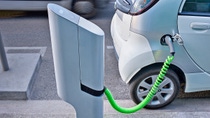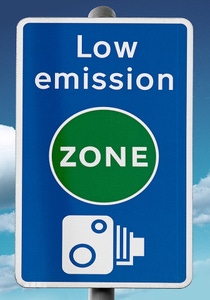99%
of NOX and particulate matter is taken out of the exhaust by the latest diesel engines.
Novice in mediji
Diesel was once considered a wonder fuel – efficient, powerful and, with lower CO2 emissions than gasoline, good for the environment. But recently the arguments against it have begun to mount. Is it clean? Is it safe? Does it have a future?
In 2015, it was revealed that some car manufacturers had cheated on diesel emissions tests, sparking a major debate about the fuel’s environmental impact. With studies linking diesel emissions to respiratory illness and cancer, calls have been made to ban diesel vehicles in several major European cities and public confidence has been shaken. Can diesel be turned around or is it the end of the road for this fuel? We ask diesel scientist Professor Thomas Koch of the Karlsruhe Institute of Technology and Julia Poliscanova, clean vehicles expert at the European lobby group Transport & Environment, for their views.
We are being very shortsighted in Europe by focusing on diesel. Electric cars have zero tailpipe emissions. I believe it should be the power behind our future mobility.“
The latest diesel engines are clean and efficient. But I believe we cannot rely on one form of power – we will need diesel, gasoline, and electric for years to come.“
Professor Thomas Koch: No, it’s not right to ban them. Modern diesel cars have a negligible impact on urban emissions. Regarding investment cost they may not be the right solution for every driving profile. However, in the latest generation the nitrogen oxide (NOX) emissions issue has been solved. Under typical driving conditions, they emit far less than the new, stricter European limits permit and even less than many gasoline engines. It’s true there are older cars that are less clean. The question is now how to optimize these, which is a different issue from banning diesel technology.
Julia Poliscanova: I agree that in future clean diesel can exist, but the reality is that the current generation of diesel cars still on the market today is not clean. Their real-time driving emissions exceed the new limits. These cars will probably be on the road for another 15 years, while the vehicles with the newest technology will not be certified for sale until 2019 at the earliest. So it’s solved in the lab, but it’s certainly not solved in real life. Cities simply don’t have other options to clean up their air.
Koch: All solutions must contribute to a world of mobility, of course without any impact on people’s health. If you make many short journeys within cities, a gasoline, gasoline hybrid, or battery-powered electric vehicle is a very good solution. As soon as you drive more than 12,000 kilometers a year, diesel becomes more attractive. Provided the technology is completely neutral in terms of health, I’m open to every technology. I do not see a real difference anymore, except where the electricity is generated from a fuel source with high greenhouse gas emissions, such as coal.
Poliscanova: The new generation gasoline vehicles will have particle filters but they still have some emissions. By comparison, electric vehicles have zero tailpipe emissions, so it’s zero versus low emissions. In terms of the environmental impact of the electricity, a study by a Belgian university, VUB, looked into the life-cycle analysis of different electric vehicles on different electricity mixes, and compared them with the life cycle of diesel vehicles. It found that only when electric vehicles are run on electricity generated entirely from coal-fired plants are they slightly worse than diesel. As we are adding more renewable energy all the time to the energy mix, the electric advantage will continue to increase.
Poliscanova: If policy makers want it, it would absolutely be possible to have an electric-only auto world by mid-century. In the medium term, gasoline engines are a perfect combination to first of all go to hybrid gasoline, then to plug-in hybrid, and finally to fully electric. The range issue has largely been solved – the fully electric vehicles coming on to the market this year or next all have a range of over 200 kilometers. In three years it will be over 300. The cost is decreasing and we will have electric vehicles that are pretty much fully competitive with conventional ones by the early 2020s. I think there is still one issue – that of charging infrastructure. However, we have time to solve this. I also think there’s a whole change in the way we see mobility. It’s a three-way revolution: electric, autonomous and shared. All three will be the future of mobility. In that respect, the electric engine is a perfect contribution.
Diesel technology will be lifted to the next level in combination with hybridization and will be further improved.”
Koch: There is no doubt that autonomous driving and shared mobility have great potential for the future, but that’s a separate issue from whether a vehicle is powered by electricity or by a combustion engine. I also agree that it’s one solution to have batterypowered electric cars, but why push this technology alone? There are some real disadvantages: the weight of the cars, the range, fossil-based electricity generation and the cost of infrastructure, which will be passed on to the consumer through taxes and fees. Also, imagine if we were not able to separate the energy for transportation, which today is basically liquid fuels, from the energy for other purposes – think how vulnerable the whole economy would be if there were a breakdown. I believe we will need diesel, gasoline and hybrid engines for quite a long time.
Koch: For long-haul trucks, in particular, diesel engines will continue to give the best environmental balance, but also for medium and longer distance cars. For a standard sedan, the diesel is simply the better drive train, with 10 to 20 percent fewer CO2 emissions in comparison with gasoline and less than a gasoline hybrid. Taking into consideration the complete production of diesel, from the well to the tank as well as from the tank to the wheel, the diesel engine has a lower CO2 impact than gasoline. So we need it, that’s the message in brief.
Poliscanova: It is true, per kilometer a diesel engine is more efficient than gasoline. But in the last few years, we have seen gasoline engines catch up, and the difference in CO2 emissions today is very small, especially for smaller cars. Diesel, by contrast, is driving the wrong kind of consumer behavior by encouraging people, especially in Europe, to buy bigger cars, thus nullifying the advantage. With trucks, diesel will continue to play a role, but long term there are other solutions. We might not have all trucks electric because of battery weight, but other options{bioInclude e-highways, where trucks are powered by overhead electric cables.
In the last few years, gasoline engines have caught up with diesel. The difference in CO2 emissions today is very small.”
Poliscanova: According to the European Consumer Association, electric vehicles are becoming the better solution in terms of total cost of ownership. One recently updated study by Element Energy found that they will catch up with conventional cars in the next few years. If you look at lease contracts, which is already a big part of the market, electric vehicles have reached parity with diesel vehicles. By the early 2020s they will also reach parity with private vehicle owners. From the perspective of consumers, I think the one issue they still have with electric vehicles is that there are not enough models offered on the market. If there were, consumers would buy more electric cars today.
Koch: The total cost of ownership of electric vehicles is still higher than diesel. For many operating conditions, they are not competitive. Also, without gasoline and diesel’s contribution to tax income, which in Germany is about €36 billion, the battery electric vehicle would come under pressure. However, as I said, I see electric as another interesting approach which makes sense for certain uses. I would be happy having competitive battery- powered vehicles. But diesel will remain an attractive, consumer-friendly option for a very long time.
Koch: If the subsidies for electric cars were reduced, this technology would definitely come under pressure. I agree that electric cars are an interesting approach, and for urban mobility pure electric vehicles do make sense to a certain extent. What governments should do is set environmental standards and let the market offer vehicles that meet those standards, rather than defining which technology we use. Diesel technology will be lifted to the next level in combination with hybridization and will be further improved. It will continue to be an attractive alternative for consumers for years, independent of the level of taxes, as well as being the most environmentally friendly way to move.
Poliscanova: In Europe, the lower taxes on diesel mean that around 50 percent of new sales are diesel cars. But if you look at markets where there is no diesel subsidy, sales are below 5 percent. In the U.S., they are less than 1 percent and in China less than 2 percent. The biggest change we would see in Europe if we were not subsidizing any fuel is that demand for diesel would drop and we would produce more smaller compact city vehicles. We don’t need more than that in European cities.
Poliscanova: The main minus of diesel is the complexity required to clean it up. Yes, we can add another technological solution, another exhaust after-treatment, another pipe, another catalyst, another sensor, but as such diesel is just very complicated and that makes it expensive. In comparison, electric vehicles are simple, clean and low maintenance. Also, we should consider the competitiveness issue: 70 percent of global light duty diesel vehicles are sold in Europe. The share in the U.S. and China is less than 1 percent. You cannot ignore the fact that other regions in the world aren’t going down the diesel path. My personal belief is that the future is electric.
Koch: I wonder why opponents of diesel technology argue by ignoring so many facts. But we do not disagree on one point: What we are doing today is not environmentally friendly – we import fossil fuel and burn it here in Europe. What we need to do instead is develop completely synthetic fuels, hydrocarbons, that are 100 percent environmentally friendly. We’ve started working on this and it is the right way forward to build on this important technology. For now, affordable diesel provides the freedom to drive quickly anywhere at any time in every weather – at minus 15 degrees Celsius or plus 40 degrees Celsius. One of mankind’s dreams.
The future of mobility may one day be electric, but we believe diesel still has an important role to play. That is why our chemistry supports the development of a range of clean technologies, from the latest diesel engines to battery-powered electric vehicles.
At BASF’s Hanover Engine Lab, future catalyst technologies are tested for their functionality and durability.
If we take current estimates about global warming seriously, we need diesel. It has a clear advantage over gasoline in terms of CO2 emissions and fuel efficiency. What is more, the latest diesel engines are the cleanest ever, taking 99 percent of NOX and particulate matter out of the exhaust. Nor is this just under laboratory conditions. The new Real Driving Emissions test mandated by the European Union in 2017 measures the pollutants emitted from all new certified cars under real driving conditions, proving that new diesel vehicles run cleanly not just in the testing laboratory but also on the road. Fortunately, these stringent standards are already achievable, thanks in part to the contributions of BASF chemists and engineers. Our catalyst technologies and after-treatments help new vehicles pass the toughest environmental tests.
I strongly believe that in the future battery electrical vehicles will gain a significant market share and going to play an important role in the future mobility mix. For the foreseeable future, range, battery weight and power output will continue to restrict the value of pure electric vehicles to short commutes and light commercial uses. Expense will also be an inhibiting factor for some time. To match total cost of ownership with an internal combustion engine, the battery cost would have to fall considerably. Here again BASF makes important contributions toward these goals. The company produces and develops advanced cathode materials for lithium-ion batteries and is exploring next-generation battery material concepts, including lithium-sulfur technology.
99%
of NOX and particulate matter is taken out of the exhaust by the latest diesel engines.
As electric vehicles are still a technology in the early stages, we need clean diesel as part of the mobility mix, particularly if we are to meet the Paris Climate Accord goal of restricting global warming to 2 degrees celsius. It’s fine to think about an electric future, but if we want a livable one, we need a range of clean technologies. And instead of hoping for an electrical mobility revolution it makes more sense to use all options in place. Synthetic fuels (CO2 neutral), for example, could also play an important role in achieving global CO2 targets
The future of mobility has to be sustainable. How we meet that goal must be the subject of continuing fact-based discussion. Meanwhile, our technologies will continue to make a variety of clean options possible so the consumer can choose the one that best suits their needs.




